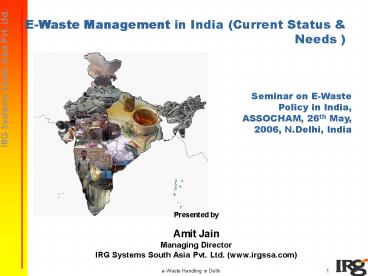EWaste Management in India Current Status - PowerPoint PPT Presentation
1 / 31
Title:
EWaste Management in India Current Status
Description:
Plastic Extractor. Electronic Item Extractor. Metal Extractor. End User ... Extractors/Recyclers. Consumer. Pilot Study -Tracer Analysis. E-waste trade chain ... – PowerPoint PPT presentation
Number of Views:783
Avg rating:3.0/5.0
Title: EWaste Management in India Current Status
1
E-Waste Management in India (Current Status
Needs )
Seminar on E-Waste Policy in India, ASSOCHAM,
26th May, 2006, N.Delhi, India
Presented by Amit Jain Managing Director IRG
Systems South Asia Pvt. Ltd. (www.irgssa.com)
2
Contents
- Historical Perspective
- Current Status
- - What has been done
- - In Pipeline
- In Pipeline
- Major Issues
3
Historical Perspective Year 2003
- Toxics Link reports on e-waste generation and
imports - in India
- Outcome
- e-waste a new subject in India both for
generators regulators - No appreciation of problem due to lack of
awareness - No estimates of actual amount of e-waste in India
- No methodology for baseline estimates
- No intervention
4
Status 2005-2006 (What has been done)
5
What has been done
- National Level
- PILOT LEVEL DELHI STUDY- 2004
- NATIONAL LEVEL TASK FORCE (CPCB) - 2004
- E-WASTE MANUAL APRIL 2005
- TOR FOR CITY TEAM APRIL 2005
- STANDARDIZED/UNIFORM APPROACH METHODOLOGY-APRIL
2005 - DATABASE FORMATS FOR ASSESSMENT APRIL 2005
- TOR FOR PROJECT COORDINATOR APRIL 2005
- NATIONAL LEVEL ASSESSMENT JULY 2005
- PRIORITIZATION OF CITIES JULY 2005
- EXISTING RECYCLING STATUS
6
What has been done
- State Level
- EWA formed in Bangalore (Industry Association/
Industry/ NGO) - E-Parisara Recycling facility in Bangalore
- Facility in Chennai
7
Pilot Study Delhi (2003-04)
8
Pilot Study -Tracer Analysis
E-waste trade chain
9
Tracer Analysis (contd.)- Dissembling of CRT and
extraction of components
10
Tracer Analysis (contd.) - Re-gunning of CRT
11
Whats Happening PWB (Printed Wiring Boards)
Step 0 Inspecting raw material PWB with varnish
or multilayer Step 1 remove varnish manually with
spate and water. Residues washed away! Step
2 PWBs submerged in sulphuric acid to remove Cu
layer (12hrs) Step 3 pouring acid to stainless
steel tub and boil of the water (firing with
PWBs!). Remove Cu-Sulphate crystals for
selling. Step 4 remaining acid solution is poured
into plastic drums and iron scrap (for instance
Fe wires) is added to fallout Cu. Step 5 the
solution is poured in drums for settling. Cu
sludge is recovered. Solution is thrown. Cu is
sold. Step 6 glass fiber residues are stocked
(further use unclear). Some cleaning / rinsing
processes take place here. water hose runs
constantly and dilutes effluents Step 7 behind
the factory wall are rice/ paddy and vegetable
fields. Effluents end up here
acid washing / burning
12
Gold Extraction
13
Pilot study -Scenario analysis
Source MAIT Survey Findings Assumption Two
trucks include imports domestic market
14
E-Waste Trend/ Projections in Delhi
15
Items selected for national level study
16
Obsolescence Rate WEEE Generation
The total WEEE generation in India has been
estimated to be 146180 tonnes per year based on
selected EEE tracers items. This figure does not
include WEEE imports.
17
WEE Generation Top Ten States
18
19
WEE Projections
20
Fundamentals of Approach Methodology Cradle
to Grave Model
- eee generation Import manufacturing of EEE
- eee sales
- eee consumption (stock)
- weee generation
- Re- use / down cycle
- Re- cycle
- secondary raw material / disposal
21
Fundamentals of Approach Methodology Cradle
to Grave Model
Market Supply Method
Tracer Analysis
22
Approach Methodology
- 1. Market Supply Method
- - Estimate the e-waste through secondary data
- - Obsolescence rate/ Average life time
determination through market research - Confirmation by Tracer Analysis
- (Material Flow Analysis)
- - Identify the ewaste streams
- - Identify the e- waste processes
- - Identify a tracer
- - Follow the tracer through the process in the
e-waste stream - - Identify the products, by products and waste
products - - Confirm the obsolescence rate/ Average life
determined through market research
23
Approach Methodology (Contd.)
- Analysis/ Estimation
- - Analysis/ Estimation of e-waste trade value
chain - - Analysis/ Estimation of material flows
- - Identify and assess the impacts
- - Establish e-waste trade economics
24
Existing Dismantling/ Recycling Technologies for
TV/ PC in India
25
Status 2005-2006 (In pipeline)
26
In Pipeline
- National Level
- Regulatory Interventions (GTZ/ HAWA)
- ESM guidelines
27
In Pipeline
- State Level
- Bangalore assessment Study GTZ/ HAWA
- Mumbai assessment study IRGSSA
- Pune assessment study IRGSSA
- Awareness workshop in West Bengal organized by
WBPCB in association with Bengal Chambers of
Commerce Industries
28
Guidelines - Scope of Work
- Choice of environmentally sound
technologies/processes for e-waste recycling
including control of emission/discharges and
disposal of E-waste recycling wastes. - Environmentally sound recycling of Printed
Circuit Boards (PCB) including control of
emissions/discharges and disposal of E-waste
recycling wastes. - Identification of the E-waste, which can be
recycled by the SSI Sector and large sector
organization.
29
Major issues?
30
Issues?
- Do we need new rules on e-waste?
- Does the existing regulatory regime provides
enough space to accommodate e-waste? - How to design collection, transportation and
recycling system in India? - How informal recycling sector should be involved
in any collection, transportation and recycling
system? - Applicability of EPR in Indian conditions?
31
THANK YOU































